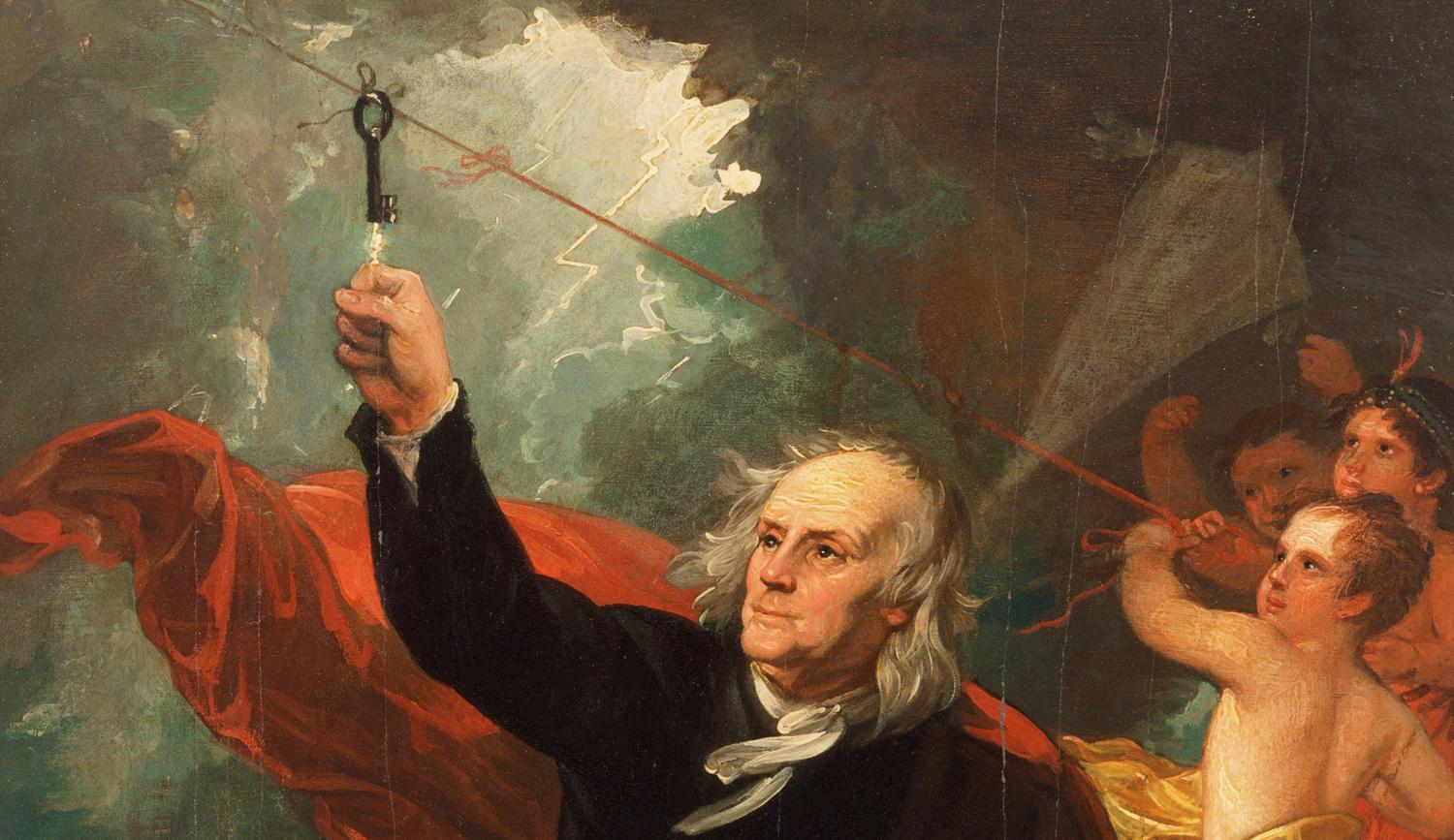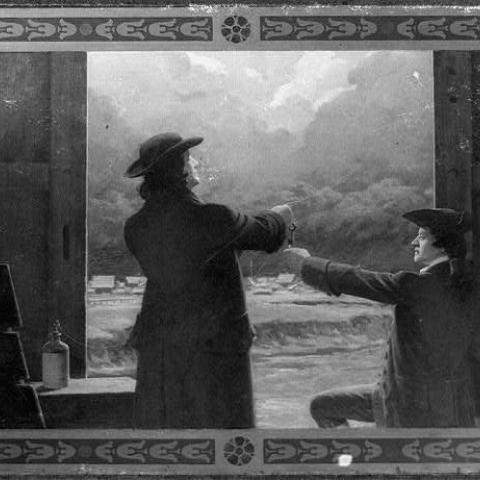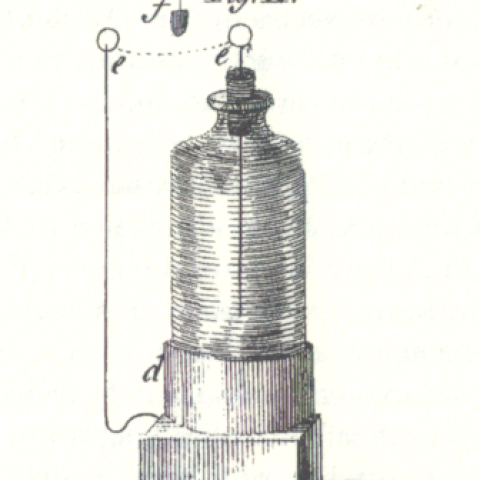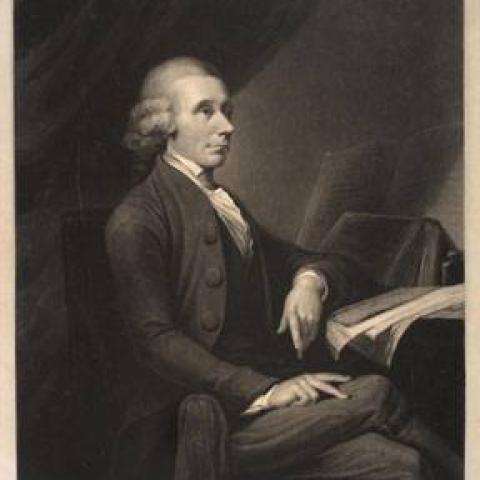
We all know the story of Franklin’s famous kite-in-a-thunderstorm experiment. But is it the true story?
On a June afternoon in 1752, the sky began to darken over the city of Philadelphia. As rain began to fall and lightning threatened, most of the city’s citizens surely hurried inside. But not Benjamin Franklin. He decided it was the perfect time to go fly a kite.
Franklin had been waiting for an opportunity like this. He wanted to demonstrate the electrical nature of lightning, and to do so, he needed a thunderstorm.
He had his materials at the ready: a simple kite made with a large silk handkerchief, a hemp string, and a silk string. He also had a house key, a Leyden jar (a device that could store an electrical charge for later use), and a sharp length of wire. His son William assisted him.
Franklin had originally planned to conduct the experiment atop a Philadelphia church spire, according to his contemporary, British scientist Joseph Priestley (who, incidentally, is credited with discovering oxygen), but he changed his plans when he realized he could achieve the same goal by using a kite.
So Franklin and his son “took the opportunity of the first approaching thunder storm to take a walk into a field,” Priestley wrote in his account. “To demonstrate, in the completest manner possible, the sameness of the electric fluid with the matter of lightning, Dr. Franklin, astonishing as it must have appeared, contrived actually to bring lightning from the heavens, by means of an electrical kite, which he raised when a storm of thunder was perceived to be coming on.”
Despite a common misconception, Benjamin Franklin did not discover electricity during this experiment—or at all, for that matter. Electrical forces had been recognized for more than a thousand years, and scientists had worked extensively with static electricity. Franklin’s experiment demonstrated the connection between lightning and electricity.
The Experiment
To dispel another myth, Franklin’s kite was not struck by lightning. If it had been, he probably would have been electrocuted, experts say. Instead, the kite picked up the ambient electrical charge from the storm.
Here’s how the experiment worked: Franklin constructed a simple kite and attached a wire to the top of it to act as a lightning rod. To the bottom of the kite he attached a hemp string, and to that he attached a silk string. Why both? The hemp, wetted by the rain, would conduct an electrical charge quickly. The silk string, kept dry as it was held by Franklin in the doorway of a shed, wouldn’t.
The last piece of the puzzle was the metal key. Franklin attached it to the hemp string, and with his son’s help, got the kite aloft. Then they waited. Just as he was beginning to despair, Priestley wrote, Franklin noticed loose threads of the hemp string standing erect, “just as if they had been suspended on a common conductor.”
Franklin moved his finger near the key, and as the negative charges in the metal piece were attracted to the positive charges in his hand, he felt a spark.
“Struck with this promising appearance, he immediately presented his knucle [sic] to the key, and (let the reader judge of the exquisite pleasure he must have felt at that moment) the discovery was complete. He perceived a very evident electric spark,” Priestley wrote.
Using the Leyden jar, Franklin “collected electric fire very copiously,” Priestley recounted. That “electric fire”—or electricity—could then be discharged at a later time.
Franklin’s own description of the event appeared in the Pennsylvania Gazette on October 19, 1752. In it he gave instructions for re-creating the experiment, finishing with:
As soon as any of the Thunder Clouds come over the Kite, the pointed Wire will draw the Electric Fire from them, and the Kite, with all the Twine, will be electrified, and the loose Filaments of the Twine will stand out every Way, and be attracted by an approaching Finger. And when the Rain has wet the Kite and Twine, so that it can conduct the Electric Fire freely, you will find it stream out plentifully from the Key on the Approach of your Knuckle. At this Key the Phial may be charg’d; and from Electric Fire thus obtain’d, Spirits may be kindled, and all the other Electric Experiments be perform’d, which are usually done by the Help of a rubbed Glass Globe or Tube; and thereby the Sameness of the Electric Matter with that of Lightning compleatly demonstrated.
Franklin wasn’t the first to demonstrate the electrical nature of lightning. A month earlier it was successfully done by Thomas-François Dalibard in northern France. And a year after Franklin’s kite experiment, Baltic physicist Georg Wilhelm Richmann attempted a similar trial but was killed when he was struck by ball lightning (a rare weather phenomenon).
After his successful demonstration, Franklin continued his work with electricity, going on to perfect his lightning rod invention. In 1753, he received the prestigious Copley Medal from the Royal Society, in recognition of his “curious experiments and observations on electricity.”
By Nancy Gupton. Published June 12, 2017.




